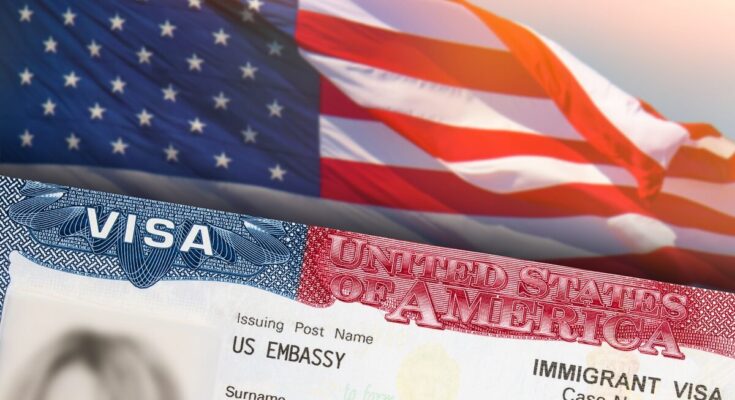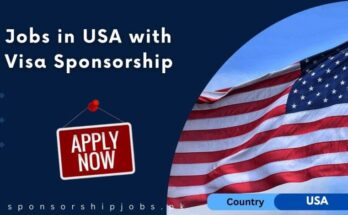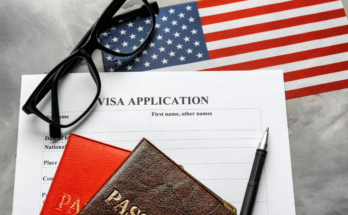The dream of living and working in the United States is a goal for millions of people worldwide. However, navigating the visa system can often feel like a maze. One promising pathway is the USA Express Visa, designed to speed up the immigration process for eligible individuals.
A key factor that helps applicants secure this type of visa is visa sponsorship, where either an employer, a family member, or an educational institution supports the immigrant’s application.
In this guide, we’ll explore how the express visa works, the importance of sponsorship, and how you can improve your chances of success.
What is the USA Express Visa?
An Express Visa in the United States aims to streamline the immigration process for certain applicants, making it faster and more efficient. These visas may not be a single official category but are typically a combination of priority processing visas such as employment-based or family-sponsored options. The term often refers to high-demand visas where processing times are reduced for applicants meeting critical criteria.
Key categories under this “express” concept include:
- Employment-based visas (e.g., H-1B)
- Family-sponsored visas
- Priority worker visas (EB-1 category)
These express pathways help fill critical labor shortages in the U.S. economy or facilitate family reunification.
The Role of Visa Sponsorship
Visa sponsorship is when a U.S.-based entity, such as an employer or family member, supports an applicant’s visa by providing essential documentation and often committing to financial or legal responsibilities. For many immigrants, sponsorship is essential because it improves the likelihood of their application being approved.
Without sponsorship, applicants may face limited options unless applying through specialized programs like the Diversity Visa (Green Card) lottery or investment-based visas.
Key benefits of sponsorship include:
- Demonstrating eligibility: Sponsors confirm that you meet visa requirements.
- Financial backing: Sponsors assure the U.S. government that you won’t become a public charge.
Types of Visa Sponsorship Available in the USA
Several forms of sponsorship exist depending on the applicant’s circumstances. Let’s dive into the main categories:
Employer-Sponsored Visas:
- Most common for skilled professionals, particularly under the H-1B and L-1 categories.
- Employers must file a petition with U.S. Citizenship and Immigration Services (USCIS).
Family-Sponsored Visas:
- U.S. citizens and lawful permanent residents can sponsor close relatives.
- Popular categories include immediate relatives (spouses, parents, children).
Educational Sponsorships:
- Educational institutions may sponsor student visas (F-1, M-1, etc.).
- Many students can later transition to work visas through the Optional Practical Training (OPT) program.
How to Apply for an Express Visa in the USA
Securing an express visa requires proper planning and documentation. Here’s a step-by-step breakdown:
- Determine Eligibility
- Check if you qualify for expedited processing. For employment visas, priority is often given to those with highly specialized skills.
- Family-based applicants must have a qualified sponsor in the U.S.
- Complete Form DS-160 (for non-immigrant visas) or the relevant application for immigrant visas.
- Pay the application fees, which vary by visa type.
- Gather Required Documents
- Proof of sponsorship (job offer, affidavit of support, etc.)
- Educational certificates, financial statements, and other relevant documents
- Attend an Interview
- Prepare for a visa interview at the U.S. consulate.
- Wait for Processing
- Express visas typically undergo faster processing, but delays can still occur depending on workload and security checks.
Employer-Sponsored Visa Categories
Employer sponsorship is often the most reliable route for skilled workers looking to move to the U.S. Some key visa types include:
- H-1B Visa: For specialty occupations requiring advanced skills
- L-1 Visa: For employees transferring within multinational companies
- EB-2 and EB-3 Visas: For professionals with advanced degrees or exceptional skills
Employers must demonstrate that no qualified U.S. worker is available for the position, a process known as labor certification. This ensures that the visa applicant isn’t displacing American workers.
Family-Based Visa Sponsorship
U.S. citizens and permanent residents can sponsor certain relatives under the family reunification system. This includes:
- Immediate relatives: Spouses, children under 21, and parents of U.S. citizens
- Preference categories: Siblings, adult children, and other extended family members
Sponsors must submit an Affidavit of Support (Form I-864), proving they have the financial resources to support the immigrant.
Student Visa Sponsorship and Education Pathways
Educational sponsorship primarily applies to international students. Universities issue Form I-20, enabling applicants to apply for an F-1 or M-1 student visa.
Many students eventually transition to work visas through training programs like OPT or Curricular Practical Training (CPT). This pathway often serves as a stepping stone to long-term sponsorship opportunities in the U.S.
How to Find a Sponsor for Your Visa
Securing a visa sponsor can be a challenge, but with the right approach, you can improve your chances significantly. Here are some effective strategies to help you find a sponsor:
Networking
- Connect with people in your industry through events, professional groups, or social media platforms like LinkedIn.
- Personal recommendations and referrals often lead to sponsorship opportunities.
Online Job Portals
- Websites like Indeed, Glassdoor, and LinkedIn regularly feature job listings that indicate sponsorship availability.
- Use search filters such as “visa sponsorship available” to narrow down opportunities.
Apply to Multinational Companies
- Large corporations with a global presence are more likely to offer sponsorships for skilled workers.
- Companies that frequently hire immigrants include Google, Amazon, and Microsoft.
Recruitment Agencies
- Some staffing agencies specialize in placing international candidates with employers that offer sponsorship.
By being proactive and tailoring your job applications to positions that explicitly mention visa support, you increase your chances of finding a sponsor.
Common Challenges Faced by Immigrants During the Visa Process
Applying for a U.S. visa, particularly under express or sponsorship-based programs, can present several hurdles. Understanding these challenges helps you prepare better:
Processing Delays
- Even with express visas, security checks, administrative reviews, and staffing shortages at consulates can cause significant delays.
- Changes in immigration policies may also impact processing times.
Application Denials
- Common reasons for rejection include missing documentation, incomplete applications, and lack of evidence for sponsorship.
- Having an attorney review your application can minimize errors.
Finding a Suitable Sponsor
- Not all job offers come with sponsorship, especially for entry-level positions.
- Sponsorship requirements, such as labor certifications, can deter smaller employers from sponsoring visas.
Cultural and Legal Adjustments
- Immigrants often face difficulties adjusting to new legal, tax, and cultural expectations in the U.S.
While these obstacles may seem daunting, careful planning and perseverance can help you overcome them.
Tips for a Successful Visa Sponsorship Application
A successful visa sponsorship application requires meticulous preparation. Here are some tips to increase your chances of approval:
Organize Your Documentation
- Ensure all your paperwork, including your resume, educational certificates, job offer letter, and sponsorship documentation, is complete and up to date.
- Double-check application forms for accuracy.
Prepare for the Visa Interview
- Expect questions about your sponsor, job responsibilities, and plans in the U.S.
- Be confident, clear, and honest in your responses.
Work Closely with Your Sponsor
- Employers or family sponsors must provide critical documents, such as Form I-129 for work visas or Form I-864 for family sponsorship.
- Maintain open communication with your sponsor to avoid delays in submission.
Seek Professional Help
- Immigration attorneys and consultants can help you navigate complex requirements and avoid pitfalls.
- Many applicants who use legal support have higher success rates.
By staying organized and well-informed, you can greatly improve your chances of securing a visa.
Benefits of Visa Sponsorship for Immigrants
Visa sponsorship offers numerous advantages to immigrants, particularly for those looking for long-term opportunities in the U.S.:
Work Authorization
- Sponsored visas, like the H-1B, allow immigrants to legally work in the U.S. for specific employers.
- With sponsorship, you can also access worker benefits such as health insurance and retirement plans.
Path to Permanent Residency
- Many sponsorship-based visas offer a pathway to a green card.
- For instance, after several years of working under an H-1B visa, applicants can apply for permanent residency through employer sponsorship.
Stability for Families
- Family members of sponsored visa holders can often accompany them to the U.S. on dependent visas.
- Dependents may also have access to education and healthcare services.
These benefits make visa sponsorship a vital stepping stone for immigrants seeking better opportunities in the U.S.
Cost of Visa Sponsorship and Associated Fees
Both employers and applicants must be aware of the costs involved in the sponsorship process. Understanding these expenses helps avoid surprises during the application journey.
Employer Costs
- Companies sponsoring work visas often bear expenses such as:
- Filing fees for forms like I-129
- Attorney fees for legal representation
- Labor certification fees (for certain employment-based visas)
- In some cases, employers are required by law to cover these costs to protect workers from exploitation.
Applicant Costs
- Applicants may need to pay for:
- Visa application fees
- Medical examinations and related documentation
- Travel expenses for visa interviews and relocation
Fee Waivers
- Some family-based applicants may qualify for fee waivers under certain conditions, particularly if they demonstrate financial hardship.
Knowing these costs in advance helps both sponsors and applicants plan effectively for the process.
Express Visa and Sponsorship Success Stories
Hearing real-life stories of immigrants who successfully obtained express visas and sponsorships can be both inspiring and educational. Here are a few examples:
From Student to Tech Executive
- Maria, a software engineer from India, came to the U.S. on a student visa. After graduating, she found a job at a tech company that sponsored her H-1B visa. Today, she holds a senior executive position.
Family Reunification After Years Apart
- Ahmed, a U.S. citizen, sponsored his parents and younger siblings to join him in the U.S. through a family reunification visa. His application process faced delays but was ultimately successful.
Healthcare Workers Filling Shortages
- Several hospitals in the Midwest have expedited visa sponsorship programs for international nurses and doctors, helping to address critical labor shortages in rural areas.
These stories highlight the transformative power of visa sponsorship for individuals and families seeking a new beginning in the U.S.
Conclusion
Securing an express visa to the U.S. can be a life-changing opportunity for many immigrants. However, the process can be complex, especially when sponsorship is involved. Whether it’s through an employer, a family member, or an educational institution, having strong sponsorship support significantly enhances your chances of success. By following the steps outlined here, staying organized, and preparing thoroughly, you can turn your dream of living and working in the U.S. into reality.



